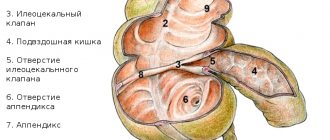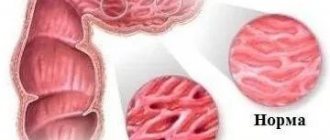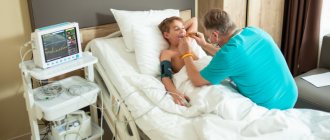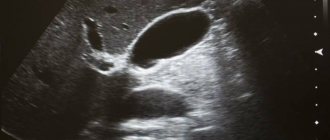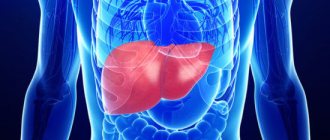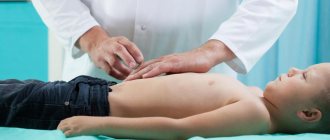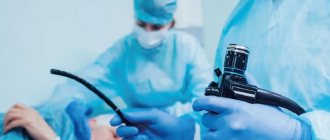Transversoptosis is a change in the anatomical position of the intestine. In the presence of the disease, prolapse or sagging of the transverse colon is observed, which resembles the letter V on X-ray photographs.
- Etiology
- Symptoms
- Diagnostics
- Treatment
- Possible complications
- Prevention and prognosis
Pathology can develop both during the period of intrauterine development of the fetus, and can be a consequence of other diseases. In some cases, provoking factors are physiological in nature.
The first clinical manifestation is increased gas formation, against the background of which other symptoms may occur: periodic pain in the abdominal area, attacks of nausea and vomiting, and other signs of deterioration in well-being.
The diagnostic process is based on the implementation of instrumental procedures, which are necessarily supplemented by laboratory tests and manipulations performed by the clinician.
After confirmation of the diagnosis, conservative attempts are made to get rid of the disease, for example, taking medications, following a diet and exercise therapy, but in the absence of positive dynamics, treatment is performed surgically.
According to the international classification of diseases of the tenth revision, pathology does not have its own code, but belongs to the category “Other intestinal diseases”. The ICD-10 code will be K55-K63.
Statistics
Although colorectal cancer is still most often diagnosed in older adults, recent statistics indicate that the incidence rate of colorectal cancer is falling by about 5% per year in adults aged 65 years and older and is declining by 1.4% per year in adults in aged from 50 to 64 years. Meanwhile, the incidence rate is increasing by almost 2% per year in adults under 50 years of age. This increase is largely due to the rising incidence of colorectal cancer. About 11% of all colorectal diagnoses occur in people under 50 years of age. The reason for this increase among young people is not known and is an active area of research.
Treatment
Treatment for ptosis is complex. The patient is prescribed laxatives or antidiarrheal drugs. In rare cases, it is necessary to take antibacterial drugs. After complete recovery, the patient undergoes a recovery course using vitamin and mineral complexes.
In some cases, the patient requires surgical treatment.
This is possible if you have:
- signs of chronic intoxication;
- intestinal obstruction;
- severe and constant pain.
Before and after the operation, the patient will need to follow all the doctor’s recommendations. This is necessary to reduce the risk of recurrence of the disorder. The complex also uses traditional methods of treatment. Highly effective:
- buckthorn bark;
- Joster fruits.
In most cases, drug treatment is prescribed.
It is recommended to prepare a decoction from the listed natural ingredients. For 1 tbsp. l. of the active substance take 350 ml of boiling water. The drink is infused throughout the day and divided into three doses. A bandage for bowel prolapse allows the patient to significantly improve their well-being. It lowers pressure in the abdominal cavity.
IBD in children: growth and development of the body is at risk
Ulcerative colitis in children can appear even before the age of one year and very quickly lead to total damage to the colon. If left untreated, the disease can result in a serious disruption of the physiological process of development of the child’s body: growth retardation or retardation in physical development. If endocrine pathology is not detected, a good pediatrician will definitely prescribe a gastrointestinal tract diagnosis for the child. In addition, this pathology causes serious psychological problems in both children and schoolchildren.
Transversoptosis
Transversoptosis is a change in the anatomical position of the intestine. In the presence of the disease, prolapse or sagging of the transverse colon is observed, which on X-ray photographs resembles the letter V. Pathology can develop both during the period of intrauterine development of the fetus, and can be a consequence of other diseases. In some cases, provoking factors are physiological in nature.
The first clinical manifestation is increased gas formation, against the background of which other symptoms may occur: periodic pain in the abdominal area, attacks of nausea and vomiting, and other signs of deterioration in well-being.
The diagnostic process is based on the implementation of instrumental procedures, which are necessarily supplemented by laboratory tests and manipulations performed by the clinician.
After confirmation of the diagnosis, conservative attempts are made to get rid of the disease, for example, taking medications, following a diet and exercise therapy, but in the absence of positive dynamics, treatment is performed surgically.
According to the international classification of diseases of the tenth revision, pathology does not have its own code, but belongs to the category “Other intestinal diseases”. The ICD-10 code will be K55-K63.
Symptoms
The first clinical manifestations, which are most often ignored by people or attributed to completely different pathologies, are increased gas formation and frequent disturbances in bowel movements (constipation).
The following symptoms are typical for transversoptosis:
- pain in the lower or middle part of the anterior wall of the abdominal cavity of a constant, pressing and aching nature;
- a sharp increase in pain when straining during defecation or after eating food; excessive physical activity can provoke a painful attack - there is a decrease in the intensity of pain in a horizontal position of the body;
- periodic nausea, which only occasionally leads to vomiting - vomiting does not bring relief;
- severe headaches;
- causeless irritability;
- sleep disturbance, including insomnia;
- frequent mood changes;
- increased heart rate;
- increase in blood tone;
- signs of ischemic heart disease;
- fatigue and general weakness;
- unpleasant sensations during the emission of urine in males;
- painful menstruation in women;
- formation of external or internal hemorrhoidal cones.
Transversoptosis does not have specific clinical manifestations that would accurately indicate the course of this particular disease.
Diagnostics
A proctologist can diagnose rectal prolapse and the degree of intestinal prolapse without even examining and analyzing symptoms. The prolapsed area of the organ has a cone-shaped, cylindrical or spherical shape, and is painted in a bright red or bluish tint. The mucous membrane is markedly swollen and bleeds on contact. In the early stages, it is possible to straighten the intestine and restore the normal state of the tissues. If prolapse is not observed at the time of examination, the patient is asked to strain to provoke prolapse.
During a digital examination, the doctor determines the tone of the sphincter and differentiates the disease from hemorrhoids and anal polyps. After this, to make an accurate diagnosis, identify complications and the exact stage of the disease, instrumental diagnostics are performed, which includes:
- colonoscopy - to identify the reasons why the pathology appeared;
- irrigoscopy - to detect functional changes in the colon;
- defectography (proctography) - to determine the degree of leakage;
- anorectal manometry - to assess muscle function;
- endoscopic examination (sigmoidoscopy) - to identify intussusception and the presence of ulcers;
- endoscopic biopsy with tissue examination - prescribed when a solitary ulcer is detected to exclude rectal cancer;
- gynecological examination – for women.
Colonoscopy of the intestine: are patients’ fears justified?
An illness diagnosed at an early stage creates the least amount of problems for the patient. Therefore, highly informative screening colonoscopy is included in government programs to combat colon cancer in the USA, Israel and European countries. Citizens of developed countries are constantly informed about the need for regular examinations for the prevention and early diagnosis of colorectal cancer.
The specifics of such an intimate procedure do not evoke the most positive emotions among Russians. Pain is a major deterrent even for those people who are fully aware of the need for testing. But is it possible to compare the sensations that arise during a colonoscopy with the torment experienced by patients suffering from already developed oncology!
It should be understood that gentle diagnostic technology, which can be performed under anesthesia, will allow you to avoid dangerous symptoms, frightening diagnoses and a solid set of diagnostic procedures in the future.
Exercise therapy and gymnastic exercises
If pathology is present, the patient is recommended to exercise moderately to improve blood flow and reduce the intensity of symptoms. Here are some effective exercises for bowel prolapse:
- in a lying position, raising two legs and holding them suspended for 5 seconds;
- imitation of cycling;
- in a lying position, pressing your legs to your stomach;
- performing the scissors exercise.
Therapeutic treatment can be achieved with the help of special exercises
Therapeutic exercises for prolapse of internal organs and intestines are highly effective and can significantly improve the condition. In addition, there is a positive effect on the entire body.
Treatment must be started immediately if symptoms are severe. Procrastination is dangerous to health. Massage for bowel prolapse also has proven benefits by doctors. It is allowed to independently stroke the surface of the abdomen to reduce pain.
Pathogenesis
The mechanism of development of transversitis differs in infectious and non-infectious processes. In acute intestinal infections, inflammation develops quickly. Under the influence of microbial exo- and endotoxins, the epithelium of the mucous membrane is damaged. The release of a large number of inflammatory mediators contributes to impaired microcirculation, decreased tissue oxygenation, and increasing edema. Pathological changes lead to deterioration of motility and water reabsorption; the muscular and serous layers of the colon may be involved in the process.
The pathogenesis of transversitis associated with chronic coprostasis is based on intestinal distension and mechanical injury to the mucous membrane from hardened feces. Inflammation in such cases is secondary and is often associated with colonic dysbiosis and activation of opportunistic microflora. With altered immune reactivity, the main damaging agents are autoantibodies to the components of the intestinal wall and mediators of allergic reactions.
Symptoms
The symptoms and signs of colorectal cancer listed in this section are the same as those of extremely common non-cancerous conditions such as hemorrhoids and irritable bowel syndrome. By paying attention to the symptoms of colorectal cancer, the disease can be detected at an early stage, when it can be successfully treated. However, many people with bowel cancer do not develop symptoms until the disease has progressed, so people need to be screened regularly.
Patients with colorectal cancer may experience the following symptoms:
- Change in frequency of bowel movements.
- Diarrhea, constipation, or a feeling that your bowels are not emptying completely.
- Bright red or very dark blood in the stool.
- Stool that looks narrower or thinner than usual.
- Abdominal discomfort, including frequent gas pains, bloating, fullness, and colic.
- Losing weight for no reason.
- Constant fatigue or malaise.
- Unexplained iron deficiency anemia, that is, a decrease in the number of red blood cells.
Talk to your doctor if any of these symptoms last several weeks or get worse.
Once diagnosed with cancer, symptom relief remains an important part of cancer care and treatment. This may be called palliative or supportive care. It often begins soon after diagnosis and continues throughout treatment.
Possible complications
Symptoms and treatment of intestinal coloptosis cannot be ignored. Pathology can cause a number of complications. Therapy should begin as early as possible.
In representatives of the stronger sex, when the intestines prolapse, they begin to put pressure on the bladder. This leads to urinary incontinence and prostatitis. The disease is no less dangerous for women. In them, the disease can turn into:
- infertility;
- menstrual irregularities;
- inflammatory processes in the uterus.
Treatment of intestinal transversoptosis should be carried out under the careful supervision of a doctor. This is the only way to get rid of the disorder as soon as possible. Some of the complications are irreversible.
Menstrual irregularities are one of the possible complications in women
Etiology and pathogenesis
The etiology of enteroptosis is unknown. Currently, 3 main theories are being considered: 1. Enteroptosis is a consequence of malnutrition. 2. Enteroptosis is a consequence of weakness of connective and muscle tissue. 3. Enteroptosis is a normal variant. Pathophysiology Most often, enteroptosis affects the most anatomically mobile parts of the intestine, for example, the colon. The descending colon becomes U-shaped, making it difficult for food and gas to pass through. In an upright position of the patient, with severe enteroptosis, the passage can almost stop, which causes a clinical picture of partial intestinal obstruction. Disorders of passage through the gastrointestinal tract in patients with visceroptosis are caused by a complex of factors: - anomaly of development and fixation of the colon; - Jackson's films, causing deformation of the right flank of the colon and distal parts of the small intestine; — connective tissue cords that form double-barreled guns in the area of the hepatic and splenic flexures of the colon; — cicatricial changes in the root of the mesentery of the sigmoid colon; - deep pelvic floor; - rectal deformities; - lengthening of the intestinal mesentery. Histologically, enteroptosis is represented by signs of catarrhal inflammation and/or atrophy of the intestinal wall (depending on the stage). Submucosal infiltration and mucosal atrophy due to chronic inflammation are combined with the death of the vast majority of ganglia and destructive changes in the intermuscular nerve plexuses.
Attention!
If you are not a medical specialist: By self-medicating, you can cause irreparable harm to your health. The information posted on the MedElement website and in the mobile applications “MedElement”, “Lekar Pro”, “Dariger Pro”, “Diseases: Therapist’s Guide” cannot and should not replace a face-to-face consultation with a doctor. Be sure to contact a medical facility if you have any illnesses or symptoms that concern you. The choice of medications and their dosage must be discussed with a specialist. Only a doctor can prescribe the right medicine and its dosage, taking into account the disease and condition of the patient’s body. The MedElement website and mobile applications “MedElement”, “Lekar Pro”, “Dariger Pro”, “Diseases: Therapist’s Directory” are exclusively information and reference resources. The information posted on this site should not be used to unauthorizedly change doctor's orders. The editors of MedElement are not responsible for any personal injury or property damage resulting from the use of this site.
Diagnostic methods
It is impossible to diagnose the disease by symptoms. Signs of a present abnormality are nonspecific. Treatment of intestinal prolapse with folk remedies and medications is selected only after visiting a doctor and establishing a final diagnosis.
At the first visit to a medical facility, the doctor will palpate and also examine the patient. However, this is not enough. The sick person undergoes:
- ultrasonography;
- radiography using a contrast agent.
Only after a final diagnosis has been made, a diet for prolapsed bowels and other therapeutic methods will be selected for the patient. The results of the studies will guarantee the adequacy of the chosen therapy.
Ultrasound is one of the mandatory types of examination to make a diagnosis.
